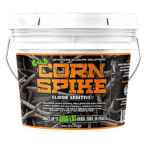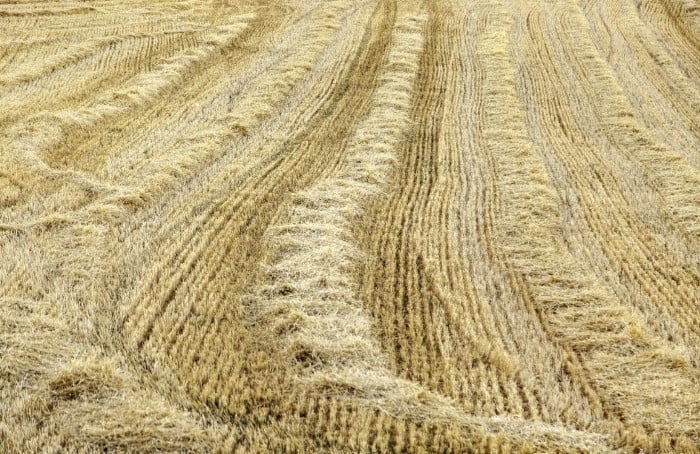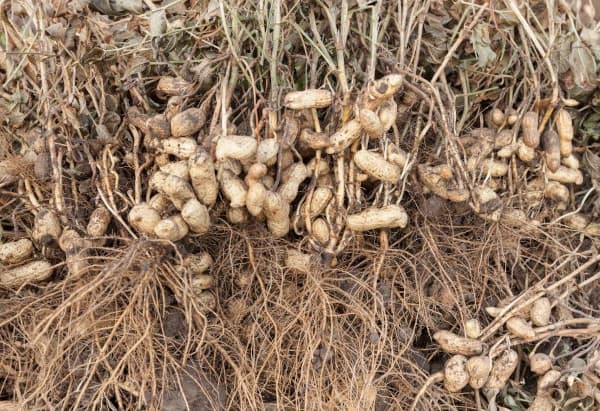I get to talk foot plots quite a bit at my day job, and one of the most common topics in my food plot conversations is soil quality. While every deer hunter or land manager wants land with perfectly pH-balanced, nutrient-rich soil, the truth is, that’s an uncommon situation. In most cases, the ground has some deficiencies, and the hunter has to find a way to successfully grow food plots despite the soil issues. One problematic soil type is dry sandy soil, so many hunters and land managers are routinely asking what are the best food plots for sandy soil?
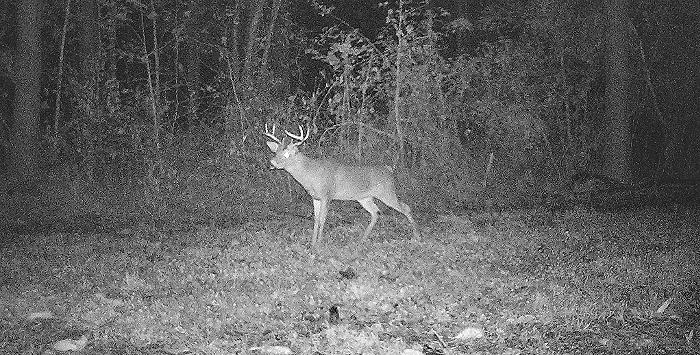
Sandy Soil Challenges
Typically speaking, sandy soil or soil that is more than 75% sand poses two significant challenges for growing a successful food plot:
It doesn’t retain water well
Much like rocky soil, sandy type soil doesn’t hold moisture well at all. The soil consistency and lack of organic matter in the soil mean that water moves through the ground very quickly. This situation makes the soil dry compared to soil with a higher volume of organic matter.
Since supplemental watering is challenging to perform consistently and quite costly, it’s not a viable solution for food plots.
It Is typically acidic with low pH and low nutrient value
Soil that predominantly consists of sand tends to be acidic with low pH values. Subsequently, the sandy type of soil is generally low in nutrients as well. The soil acidity, low pH, and low nutrients all play a role in a deer food plot’s growth success (or lack of success).
Now some of these deficiencies can be corrected, but the correction process usually requires two things:
- Time
- Money
Depending on the desired size of your plots, soil corrections can get very expensive very quickly, and may not lead to successful germination for another two or three seasons later.
Now that I’ve covered the primary issues with sandy soil let’s talk about steps to take before even planning a food plot.

Steps to Take Before Planting a Food Plot
I suggest two steps before you even start planning sandy soil food plots, and especially before you break ground on a plot.
Get a soil sample
If you’ve done any online research on food plots, I’m sure you’ve seen this advice a thousand times. However, I absolutely believe that soil testing is worth doing, especially for the cost. In my home state of NC, a soil test is either free or $4, depending on the time of year the sample is sent in.
And, if you’re trying to plant food plots in sandy soil, a soil test is absolutely worth the cost and effort. If you’re already dealing with lower-quality soil, the soil test can provide you with the following extremely useful data:
- Soil pH (which will determine if the soil is acidic or alkaline)
- Current nutrient levels
- Moisture rate (not every state lab measures this data since moisture levels vary based on recent rainfall)
Now, to be honest, when I first started dabbling in food plots, I thought the whole soil testing thing was a gimmick, and I planted my first few plots (which failed spectacularly) without any type of soil evaluation. But, lesson learned, and these days, I won’t even break ground on a new plot without having a soil test done.
Yes, the testing process can take some time, but the data from the test can be invaluable in determining the best way to move forward with seed planting.
At my day job, when hunters say that their plots did come up, only made it a few weeks, or were a complete waste of time, I first ask: have you done a soil test?
To be fair, you can undoubtedly have successful food plots without a soil test, but since I’m investing my time, effort, and money in a plot, I prefer to utilize available data versus just guesswork.
Understand Planting Zones or Planting Schedules
Once a soil sample has been completed, the next step in the process is to familiarize yourself with the planting zones for your geographical location. A planting zone (also called a planting schedule) is a suggested time to plant schedule based on the area where you live. Keep in mind that optimal planting dates are not universal across the country.
For example, a farmer in Michigan wouldn’t plant a crop of corn at the same time as a farmer in Georgia because Michigan has much colder weather, so the corn crop would need to be planted and harvested during the optimal growing season, before the freezing cold winter temperatures set in.
A planting schedule can help determine the optimum time of year to plant specific food plot crops. So I’d first start looking at the planting zone map provided by the USDA (which can be seen here), then narrow that down to your specific state.
Once you have a rough idea of the planting schedule for your state or location, I’d take the process one step further by researching the recommended planting schedule provided by the food plot seed brand you plan to use.
Nearly every reputable commercial seed provider offers a suggested planting schedule for their products based on region. Most brands use a four-region system consisting of Northern, Southern, Western, and Eastern.

Some crop brands offer a more granular breakdown of plant regions that can also be helpful in the planting process. For example, here’s the plant schedule that BioLogic offers for their plot products.
Planting schedules will vary for the various crops, but most seed planting will need to be put down the cool season, which is generally considered to be spring or late spring, or early fall to late fall.
Solutions for Planting in Sandy Soil
When dealing with the everyday challenges associated with sandy soil food plots, I usually suggest the following considerations:
- Improve the soil Ph manually
- Improve the soil Ph organically
- Focus on plots that thrive in low moisture, low Ph, and low nutrient conditions
Before we dive deeper into each suggestion, I also want to point out that some of these suggestions may come at a higher cost than others, but the size of the food plot also impacts the cost.
In an effort to minimize the costs and effort and make decisions based on actionable data, I suggest testing these options out on a small test plot and measuring the results before rolling the chosen solution out across a large plot. While this approach can take some time, it may save you some money and disappointment along the way.
Improve the soil Ph manually
This solution requires a soil test and involves changing the pH of the soil manually through the application of lime, fertilizer, or both (depending on the soil test results).
As mentioned previously, the overall size of the desired food plot can play a role in the cost.
This approach has some pros and cons, including the following:
Pros
- This is a data-based solution that offers an excellent chance for plot success.
- This approach expands the potential offering of food for a specific plot above and beyond the typical feed options for low pH soil.
Cons
- Costs associated with lime and fertilizer. Lime is relatively inexpensive, but fertilizer is more costly.
- There’s a time issue as well since lime can take between 2-4 months to reduce the pH.
- Requires some labor and effort.
- Will most likely have to be repeated once every 2-3 seasons to correct the soil.
Improve the soil Ph organically
This solution involves using specific species of plants and crops to reduce the pH organically. The best crop species to lower the pH organically are legumes. Within the legume family, I find peanuts to be the best option for this type of activity.
Peanuts can grow in sandy soil relatively well and can survive with minimal amounts of water. In addition, deer will eat the plant tops as they sprout and then dig the peanuts up as a food source when they mature.
On top of adding nitrogen to the soil (which reduces pH), peanuts also provide an additional layer of organic matter for extra water retention.
However, like most everything in life, the organic improvement of the soil pH comes with some good and bad aspects:
Pros
- Tends to cost less than the lime and fertilizer option.
- Is less labor intensive to plant compared to a lime and fertilizer treatment.
- Can be accomplished with a no-till approach with minor soil prep (shallow disking)
- Is very good for the overall health of the soil in general.
- Serves as an existing food source for now while prepping the soil for later.
Cons
- Will require a follow-up soil test to evaluate the results.
- May require two or more plantings to obtain the desired pH levels.
- It always comes with the risk that the crop won’t develop for one reason or another, so the soil pH isn’t improved.
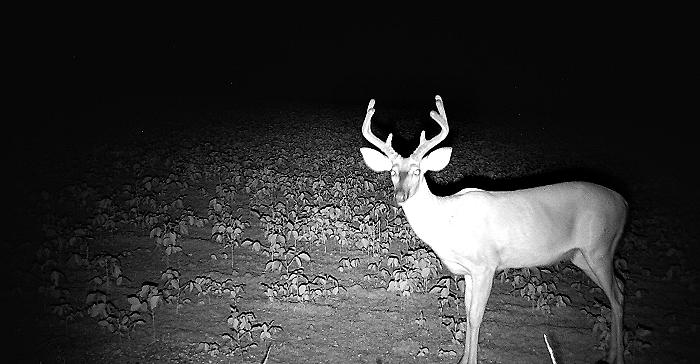
Focus on plots that thrive in low moisture, low Ph, and low nutrient conditions
For most deer hunters, this approach is the one that potentially gets the fastest results in sand-like soil. With this approach, you’ll focus on planting specific plot seeds with a track record of performing well, or better than average, in sandy soil situations.
As with any food plot set-up, seeding at the recommended time based on a specific planting schedule plays a significant role in the success or failure of these types of plots.
I also want to provide this bit of a disclaimer:
These are my favorite options for sandy soil, but there are no guarantees with food plots. Several factors go into having a successful food plot, including weather, temperatures, rainfall, etc.
In addition, if you plant enough plots, you’ll eventually have some failures. However, it’s just part of the process; try not to let it bother you. I prefer to learn from my mistakes and move on to the next season.
Here are the pros and cons of this approach:
Pros
- Typically offers the fastest results for having a operational food plot.
- Is usually less labor intensive to plant seeds in comparison to a lime and fertilizer treatment.
- Depending on the crop choice, the costs can vary significantly from crop to crop.
Cons
- Without a soil test, you’re flying blind as to which sandy soil crop will potentially perform the best.
- Comes with the inherent risk of a non-performing or failed crop for the season.
- Some crop options will have a no-till option, while others may require equipment for a successful planting.
My Five Best Deer Plots for Sandy or Loamy Soil
Here are my five best food plot seed mixtures that I plant for sandy, dry soil. Again, these five do well in my home state of North Carolina, but your own mileage in another state may vary.
Clover
Clover is one of my go-to crops for rocky or sandy soil or soil conditions with low water retention. Most clover species are relatively hardy, grow well with minimal water, and feature a root system that grows aggressively.
Clover works well in direct sun or moderate shade and is quite popular with deer.
The main drawback with clover is that it’s susceptible to overgrazing when it first sprouts. To help combat this, I generally mix in a small amount of turnip and radish seeds, or turnip and beet seeds with the clover. The turnip and radishes will come up first and act as an early food source barrier until the clover matures.

In terms of clover species, my favorite species are:
- Crimson clover
- Ladino clover
- White clover
- Red clover
Here are the following pros and cons of Winter Wheat:
Pros
- Grows well in sandy soil conditions with minimal rainfall.
- Offers several sub-species for additional food source diversity.
- Interacts well with other crops for mixed seeding options.
Cons
- When it first comes up, it’s easily overgrazed. Ideally planted with other food plot species that act as ground cover protection while the Clover matures.
- Easily compromised from competition from weeds during early germination. Performs best with weed treated plots.
- Clover is very flexible and can be planted in a no-till and traditional planting methods.
Peanuts
I already mentioned my fondness for peanuts as a means to make natural soil quality corrections. However, peanuts are also an excellent standalone food plot crop in sandy soil.
Peanuts grow well with minimal water and have a root system that spreads well in loose, sandy soil. In addition, peanuts offer a one-two punch as a deer food plot source. Deer will browse on the tops of the peanut plants when they first come out of the ground, and then feed on the nuts when they mature.
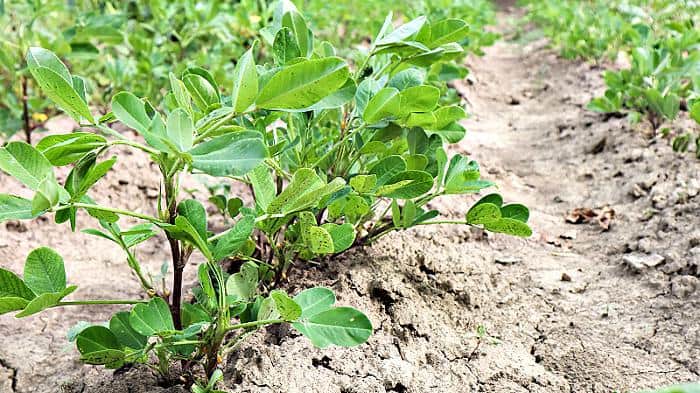
Here’s the good and bad with a peanut food plot:
Pros
- Germinates well in sandy, loose soil with minimal rainfall.
- Offers two foraging opportunities for deer with the plant tops and then the peanuts themselves.
- Introduces a significant amount of nitrogen to the soil, which helps with pH and nutrient absorption.
- When disked under, peanuts introduce additional organic matter, which aids in water retention.
Cons
- If the deer have trouble locating the nuts underground, you may have to come in with a light disking in order to get the peanuts unearthed.
- Peanuts are susceptible to excessive water, so too much precipitation annually can really reduce the harvest.
- Other species like squirrels, raccoons, etc. will also eat peanuts, so the deer have some competition with this food source.
- Does not perform well when mixed with other common food plot seeds. Works best when planted as a stand-alone crop.
Winter Wheat
Another good sandy soil food plot mix is Winter wheat. It’s a hardy crop that does well in cool to cold weather and has an extremely high germination rate. In addition, Winter wheat grows well in dry conditions and has a very high forage yield.
Plus, Whitetail deer absolutely love Winter Wheat and will come to it regardless of other available food sources. About the only food source that seems to top Winter Wheat is a natural mast crop (acorns, etc.)
Winter Wheat is my go-to plot seed in the following situations:
- I’m pushed for time and need to get a crop in the ground that is almost always guaranteed to produce.
- Situations where I can’t get any other crops to grow with a crap.
- Situations where I’m competing for deer with another nearby property with food plots or deer feeders.
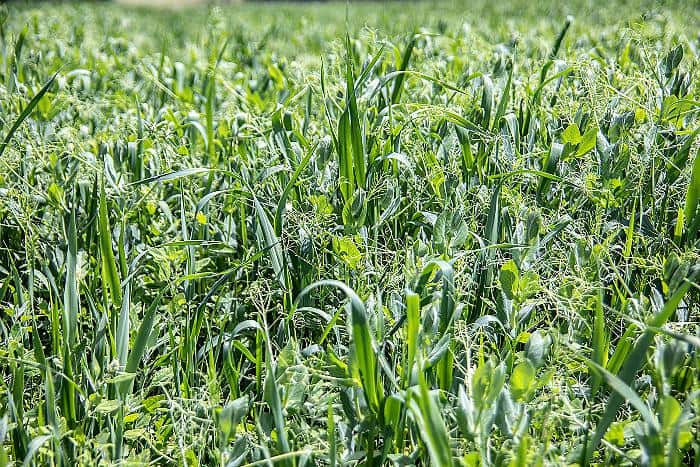
However, not all Winter wheat is equal. This version of wheat comes in two variants:
- Awned
- Awnless
While deer will forage on both, they significantly seem to prefer the awnless variety, so I’d recommend stocking to that variant style.
Here are the following pros and cons of Winter Wheat:
Pros
- Has an extremely high germination success rate.
- It’s very hardy, cold tolerant, and grows in relatively dry soil.
- It has a reasonably flexible planting schedule so that it can be planted anytime between late summer up to mid-fall.
Cons
- The awnless variety is significantly more popular with deer.
- It is susceptible to overgrazing if the deer catch it right at first germination.
- It works best if planted in conjunction with some other seed types for coverage and diversity.
Winter Peas
Another of my favorite sandy soil food crops is Winter peas because they are liked by deer and perform well in cold weather, and have what I would label as a moderate tolerance for drought. However, they do seem to require for water than Winter wheat.
I don’t find Winter Peas to be as hardy as Winter wheat, but deer seem to love the peas. They will forage on all parts of the Winter pea plant, including the plant stem, leaves, and seeds.
Winter peas are also an excellent source of nutrition for Whitetails and are advertised as being easy to digest.
The major downside with deer really liking Winter peas is the threat of early overgrazing if planted as a standalone crop. As soon as Whitetails locate the recently germinated Winter peas, they will literally mow them down in a short period of time. If the deer hit it too hard, the Winter peas won’t produce in the cold weather.
Here are the good and bad that I’ve seen with Winter peas:
Pros
- Very fast germinating and easy to plant.
- They are part of the Legume family, adding nitrogen to the soil like my Peanut example above.
- Easy to consume and digest for deer.
Cons
- Does require a certain amount of rainfall to grow well.
- They are less tolerant of low pH compared to some others on this list.
- Not as drought-resistant or cold tolerant as Winter wheat.
- Highly susceptible to overgrazing before the plants reach maturity. They won’t be available in cold weather if they don’t reach maturity. It almost always needs to be planted with other seed types for ground coverage
Chicory
My final favorite came down to a close race between Alfalfa and Chicory. Because the Alfalfa seed is expensive (compared to some of the other seeds on this list), and because Chicory returns each year if maintained properly, I picked Chicory as my winner.
There are several aspects of Chicory that I really like, including:
- Once established, Chicory has a long tap root that does well in sandy soil and makes it more drought resistant.
- Once established and properly maintained, Chicory can last for years and years in a plot with very little reseeding.
- It’s pretty popular with deer, and overgrazing typically isn’t an issue.
In my opinion, Chicory seems to perform best when planted in a mixture with other crops. While it can perform well in a standalone plot source, it’s very slow growing, so that single seed plot may not have any Chicory plants showing for months. Once germinated, Chicory spends the first few months of growth developing the long tap root and doesn’t really have a plant above ground for months.
By planting Chicory in a send blend mixture of other seeds (like clover or oats), the clover and oats will come up quickly and offer a food source while the Chicory matures.
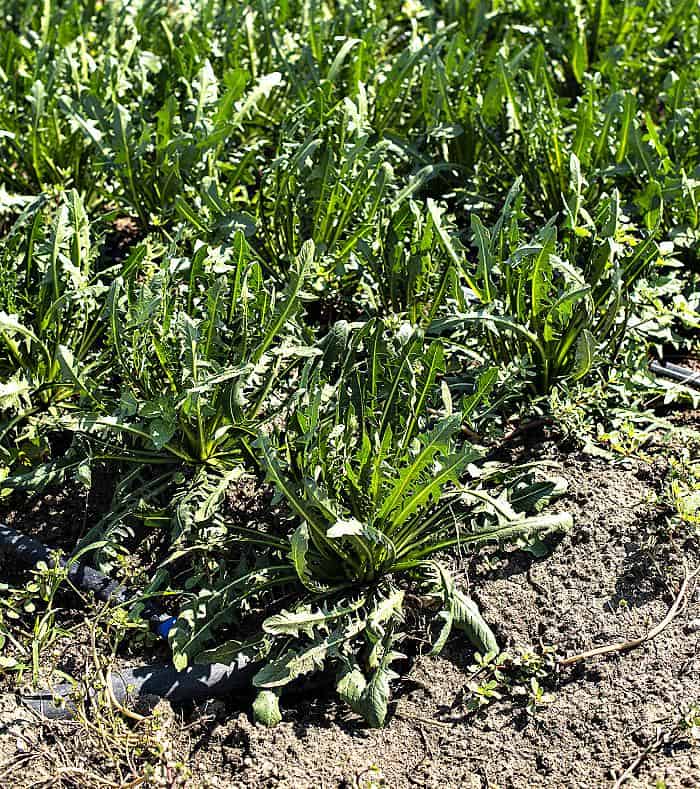
Just like most any other food plot seed for sandy conditions, Chicory isn’t perfect. Here are the pros and cons of Chicory food plots:
Pros
- It can be deployed in a no-till situation with little to no equipment.
- Once established, it can grow back after a light mowing year after year, even when deer have eaten the plant down to the ground.
- Although the seed performs best in a nutrient-rich environment, Chicory can grow in acidic soils and requires little water for successful germination.
Cons
- The slow seed development requires strict adherence to planting schedules, or the plants may not make it to the next season. So, I try to get Chicory planted as early as possible, so in North Carolina, I’m aiming to have it in the ground by mid-September.
- It requires nutrient-rich soil for optimal development but is very drought resistant. Once established, it requires work to maintain, such as liming or fertilizing annually or bi-annually.
- Chicory is very susceptible to competition from weeds, so the ideal plot will be sprayed for weeds weeks before planting. Without weed prevention, the weeds will choke out Chicory growth before the plant breaks the ground surface.
Some other food plot seed options that can perform well in sandy soil includes:
- Winter Rye
- Cereal Grains
- Brassica (A combination blend of rape and turnips is my favorite)
- Buckwheat
Hopefully, you found the information presented here a valuable resource for the challenges of sandy soil food plot options.


